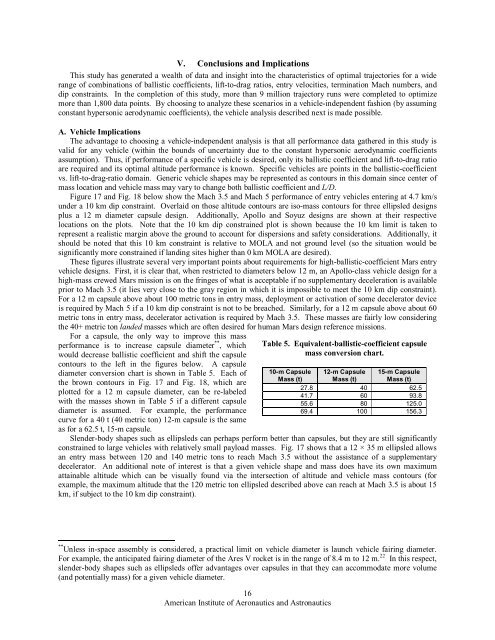Mars Entry Bank Profile Design for Terminal State Optimization
Mars Entry Bank Profile Design for Terminal State Optimization
Mars Entry Bank Profile Design for Terminal State Optimization
You also want an ePaper? Increase the reach of your titles
YUMPU automatically turns print PDFs into web optimized ePapers that Google loves.
V. Conclusions and Implications<br />
This study has generated a wealth of data and insight into the characteristics of optimal trajectories <strong>for</strong> a wide<br />
range of combinations of ballistic coefficients, lift-to-drag ratios, entry velocities, termination Mach numbers, and<br />
dip constraints. In the completion of this study, more than 9 million trajectory runs were completed to optimize<br />
more than 1,800 data points. By choosing to analyze these scenarios in a vehicle-independent fashion (by assuming<br />
constant hypersonic aerodynamic coefficients), the vehicle analysis described next is made possible.<br />
A. Vehicle Implications<br />
The advantage to choosing a vehicle-independent analysis is that all per<strong>for</strong>mance data gathered in this study is<br />
valid <strong>for</strong> any vehicle (within the bounds of uncertainty due to the constant hypersonic aerodynamic coefficients<br />
assumption). Thus, if per<strong>for</strong>mance of a specific vehicle is desired, only its ballistic coefficient and lift-to-drag ratio<br />
are required and its optimal altitude per<strong>for</strong>mance is known. Specific vehicles are points in the ballistic-coefficient<br />
vs. lift-to-drag-ratio domain. Generic vehicle shapes may be represented as contours in this domain since center of<br />
mass location and vehicle mass may vary to change both ballistic coefficient and L/D.<br />
Figure 17 and Fig. 18 below show the Mach 3.5 and Mach 5 per<strong>for</strong>mance of entry vehicles entering at 4.7 km/s<br />
under a 10 km dip constraint. Overlaid on those altitude contours are iso-mass contours <strong>for</strong> three ellipsled designs<br />
plus a 12 m diameter capsule design. Additionally, Apollo and Soyuz designs are shown at their respective<br />
locations on the plots. Note that the 10 km dip constrained plot is shown because the 10 km limit is taken to<br />
represent a realistic margin above the ground to account <strong>for</strong> dispersions and safety considerations. Additionally, it<br />
should be noted that this 10 km constraint is relative to MOLA and not ground level (so the situation would be<br />
significantly more constrained if landing sites higher than 0 km MOLA are desired).<br />
These figures illustrate several very important points about requirements <strong>for</strong> high-ballistic-coefficient <strong>Mars</strong> entry<br />
vehicle designs. First, it is clear that, when restricted to diameters below 12 m, an Apollo-class vehicle design <strong>for</strong> a<br />
high-mass crewed <strong>Mars</strong> mission is on the fringes of what is acceptable if no supplementary deceleration is available<br />
prior to Mach 3.5 (it lies very close to the gray region in which it is impossible to meet the 10 km dip constraint).<br />
For a 12 m capsule above about 100 metric tons in entry mass, deployment or activation of some decelerator device<br />
is required by Mach 5 if a 10 km dip constraint is not to be breached. Similarly, <strong>for</strong> a 12 m capsule above about 60<br />
metric tons in entry mass, decelerator activation is required by Mach 3.5. These masses are fairly low considering<br />
the 40+ metric ton landed masses which are often desired <strong>for</strong> human <strong>Mars</strong> design reference missions.<br />
For a capsule, the only way to improve this mass<br />
per<strong>for</strong>mance is to increase capsule diameter ** , which<br />
would decrease ballistic coefficient and shift the capsule<br />
contours to the left in the figures below. A capsule<br />
diameter conversion chart is shown in Table 5. Each of<br />
the brown contours in Fig. 17 and Fig. 18, which are<br />
plotted <strong>for</strong> a 12 m capsule diameter, can be re-labeled<br />
with the masses shown in Table 5 if a different capsule<br />
Table 5. Equivalent-ballistic-coefficient capsule<br />
mass conversion chart.<br />
10-m Capsule<br />
Mass (t)<br />
12-m Capsule<br />
Mass (t)<br />
15-m Capsule<br />
Mass (t)<br />
27.8 40 62.5<br />
41.7 60 93.8<br />
55.6 80 125.0<br />
69.4 100 156.3<br />
diameter is assumed. For example, the per<strong>for</strong>mance<br />
curve <strong>for</strong> a 40 t (40 metric ton) 12-m capsule is the same<br />
as <strong>for</strong> a 62.5 t, 15-m capsule.<br />
Slender-body shapes such as ellipsleds can perhaps per<strong>for</strong>m better than capsules, but they are still significantly<br />
constrained to large vehicles with relatively small payload masses. Fig. 17 shows that a 12 × 35 m ellipsled allows<br />
an entry mass between 120 and 140 metric tons to reach Mach 3.5 without the assistance of a supplementary<br />
decelerator. An additional note of interest is that a given vehicle shape and mass does have its own maximum<br />
attainable altitude which can be visually found via the intersection of altitude and vehicle mass contours (<strong>for</strong><br />
example, the maximum altitude that the 120 metric ton ellipsled described above can reach at Mach 3.5 is about 15<br />
km, if subject to the 10 km dip constraint).<br />
** Unless in-space assembly is considered, a practical limit on vehicle diameter is launch vehicle fairing diameter.<br />
For example, the anticipated fairing diameter of the Ares V rocket is in the range of 8.4 m to 12 m. 22 In this respect,<br />
slender-body shapes such as ellipsleds offer advantages over capsules in that they can accommodate more volume<br />
(and potentially mass) <strong>for</strong> a given vehicle diameter.<br />
16<br />
American Institute of Aeronautics and Astronautics
















